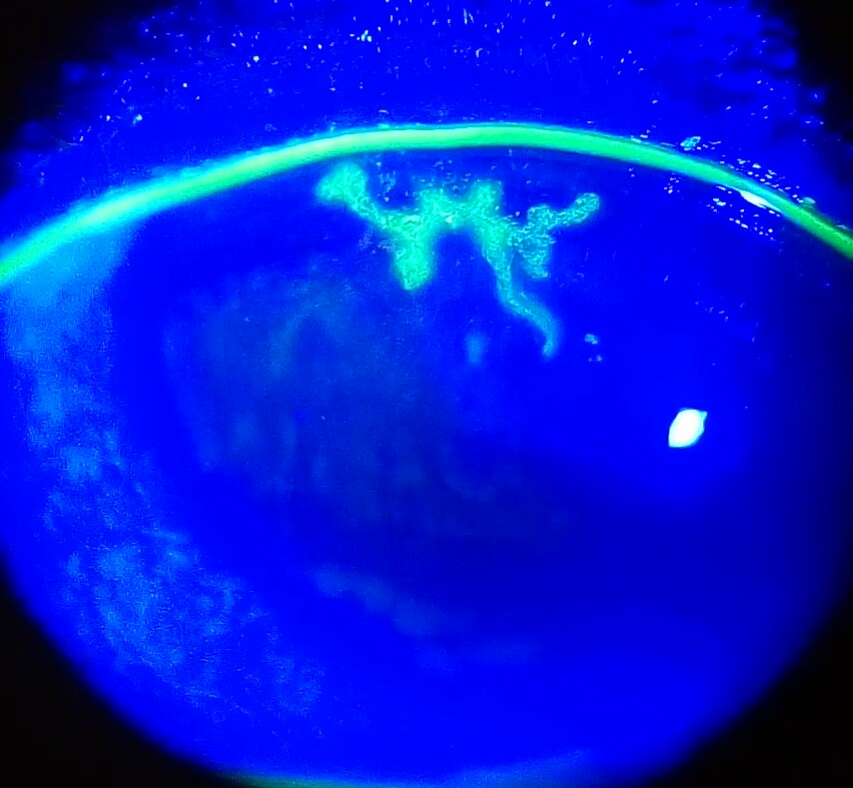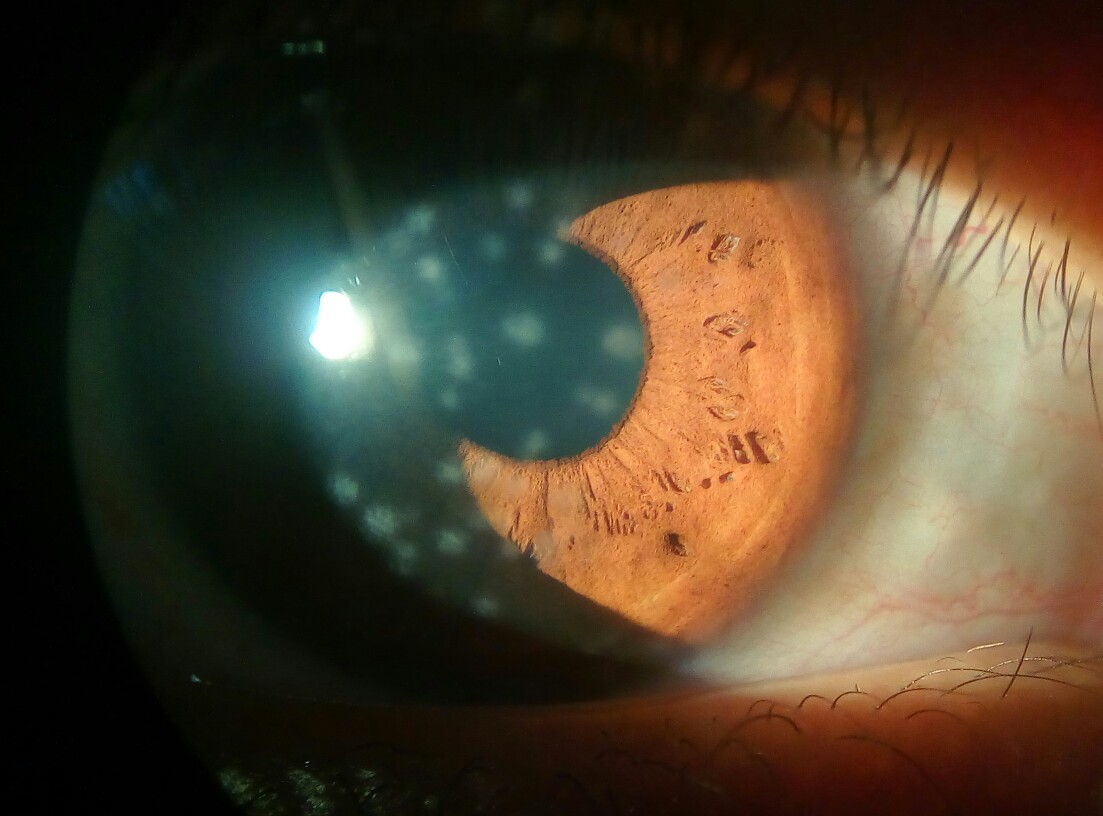Keratitis on:
[Wikipedia]
[Google]
[Amazon]
Keratitis is a condition in which the eye's


 *
*
 :* Amoebic infection of the cornea is a serious corneal infection, often affecting contact lens wearers. It is usually caused by ''
:* Amoebic infection of the cornea is a serious corneal infection, often affecting contact lens wearers. It is usually caused by ''
Facts About the Cornea and Corneal Disease
The National Eye Institute (NEI)
{{Eye pathology Inflammations Disorders of sclera and cornea
cornea
The cornea is the transparent front part of the eye that covers the iris, pupil, and anterior chamber. Along with the anterior chamber and lens, the cornea refracts light, accounting for approximately two-thirds of the eye's total optical ...
, the clear dome on the front surface of the eye, becomes inflamed
Inflammation (from la, inflammatio) is part of the complex biological response of body tissues to harmful stimuli, such as pathogens, damaged cells, or irritants, and is a protective response involving immune cells, blood vessels, and molecu ...
. The condition is often marked by moderate to intense pain and usually involves any of the following symptoms: pain, impaired eyesight, photophobia
Photophobia is a medical symptom of abnormal intolerance to visual perception of light. As a medical symptom photophobia is not a morbid fear or phobia, but an experience of discomfort or pain to the eyes due to light exposure or by presence of ...
(light sensitivity), red eye and a 'gritty' sensation.
Classification (by chronicity)

Acute
* Acute epithelial keratitis * Nummular keratitis * Interstitial keratitis * Disciform keratitisChronic
* Neurotrophic keratitis * Mucous plaque keratitisClassification (infective)
Viral

 *
* Herpes simplex keratitis
Herpetic simplex keratitis is a form of keratitis caused by recurrent herpes simplex virus (HSV) infection in the cornea.
It begins with infection of epithelial cells on the surface of the eye and retrograde infection of nerves serving the cornea ...
(dendritic keratitis). Viral infection of the cornea is often caused by the herpes simplex virus (HSV) which frequently leaves what is called a 'dendritic ulcer'.
* Herpes zoster keratitis, associated with herpes zoster ophthalmicus
Herpes zoster ophthalmicus (HZO), also known as ophthalmic zoster, is shingles involving the eye or the surrounding area. Common signs include a rash of the forehead with swelling of the eyelid. There may also be eye pain and redness, inflamma ...
, which is a form of shingles.
Bacterial
* Bacterial keratitis. Bacterial infection of the cornea can follow from an injury or from wearing contact lenses. The bacteria involved are '' Staphylococcus aureus'' and for contact lens wearers, ''Pseudomonas aeruginosa
''Pseudomonas aeruginosa'' is a common encapsulated, gram-negative, aerobic–facultatively anaerobic, rod-shaped bacterium that can cause disease in plants and animals, including humans. A species of considerable medical importance, ''P. aerug ...
. ''Pseudomonas aeruginosa'' ''contains enzyme
Enzymes () are proteins that act as biological catalysts by accelerating chemical reactions. The molecules upon which enzymes may act are called substrates, and the enzyme converts the substrates into different molecules known as products ...
s that can digest the cornea.'
Fungal
*Fungal keratitis
Fungal keratitis is a fungal infection of the cornea, which can lead to blindness. It generally presents with a red, painful eye and blurred vision. There is also increased sensitivity to light, and excessive tears or discharge.
It is caused ...
, caused by '' Aspergillus fumigatus'' and ''Candida albicans
''Candida albicans'' is an opportunistic pathogenic yeast that is a common member of the human gut flora. It can also survive outside the human body. It is detected in the gastrointestinal tract and mouth in 40–60% of healthy adults. It is usu ...
'' (cf. Fusarium
''Fusarium'' is a large genus of filamentous fungi, part of a group often referred to as hyphomycetes, widely distributed in soil and associated with plants. Most species are harmless saprobes, and are relatively abundant members of the soil mi ...
, causing an outbreak of keratitis in 2005–2006 through the possible vector
Vector most often refers to:
*Euclidean vector, a quantity with a magnitude and a direction
*Vector (epidemiology), an agent that carries and transmits an infectious pathogen into another living organism
Vector may also refer to:
Mathematic ...
of Bausch & Lomb
Bausch + Lomb is an eye health products company based in Vaughan, Ontario, Canada. It is one of the world's largest suppliers of contact lenses, lens care products, pharmaceuticals, intraocular lenses, and other eye surgery products. The compan ...
ReNu with MoistureLoc contact lens solution)
Amoebic
* Acanthamoebic keratitis :* Amoebic infection of the cornea is a serious corneal infection, often affecting contact lens wearers. It is usually caused by ''
:* Amoebic infection of the cornea is a serious corneal infection, often affecting contact lens wearers. It is usually caused by ''Acanthamoeba
''Acanthamoeba'' is a genus of amoebae that are commonly recovered from soil, fresh water, and other habitats.
''Acanthamoeba'' has two evolutive forms, the metabolically active trophozoite and a dormant, stress-resistant cyst. Trophozoites are ...
''. On May 25, 2007, the U.S. Center for Disease Control
The Centers for Disease Control and Prevention (CDC) is the national public health agency of the United States. It is a United States federal agency, under the Department of Health and Human Services, and is headquartered in Atlanta, Georgi ...
issued a health advisory due to increased risk of ''Acanthamoeba'' keratitis associated with use of Advanced Medical Optics Complete Moisture Plus Multi-Purpose eye solution.
Parasitic
* Onchocercal keratitis, which follows '' Onchocerca volvulus'' infection by infected blackfly bite. These blackfly, '' Simulium'', usually dwell near fast-flowing African streams, so the disease is also called "river blindness".Classification (by stage of disease)
* Superficial punctate keratitis * Ulcerative keratitisClassification (by environmental aetiology)
* Exposure keratitis (also known as exposure keratopathy) — due to dryness of the cornea caused by incomplete or inadequate eyelid closure ( lagophthalmos). *Photokeratitis
Photokeratitis or ultraviolet keratitis is a painful eye condition caused by exposure of insufficiently protected eyes to the ultraviolet (UV) rays from either natural (e.g. intense sunlight) or artificial (e.g. the electric arc during welding) ...
— keratitis due to intense ultraviolet radiation
Ultraviolet (UV) is a form of electromagnetic radiation with wavelength from 10 nm (with a corresponding frequency around 30 PHz) to 400 nm (750 THz), shorter than that of visible light, but longer than X-rays. UV radiation i ...
exposure (e.g. snow blindness or welder's arc eye.)
* Contact lens acute red eye (CLARE) — a non-ulcerative sterile keratitis associated with colonization of Gram-negative
Gram-negative bacteria are bacteria that do not retain the crystal violet stain used in the Gram staining method of bacterial differentiation. They are characterized by their cell envelopes, which are composed of a thin peptidoglycan cell wa ...
bacteria on contact lenses
Contact lenses, or simply contacts, are thin lenses placed directly on the surface of the eyes. Contact lenses are ocular prosthetic devices used by over 150 million people worldwide, and they can be worn to correct vision or for cosmeti ...
.
Treatment
Treatment depends on the cause of the keratitis. Infectious keratitis can progress rapidly, and generally requires urgent antibacterial, antifungal, or antiviral therapy to eliminate the pathogen. Antibacterial solutions includelevofloxacin
Levofloxacin, sold under the brand name Levaquin among others, is an antibiotic medication. It is used to treat a number of bacterial infections including acute bacterial sinusitis, pneumonia, H. pylori (in combination with other medications), ...
, gatifloxacin, moxifloxacin
Moxifloxacin is an antibiotic, used to treat bacterial infections, including pneumonia, conjunctivitis, endocarditis, tuberculosis, and sinusitis. It can be given by mouth, by injection into a vein, and as an eye drop.
Common side effects in ...
, ofloxacin
Ofloxacin is a quinolone antibiotic useful for the treatment of a number of bacterial infections. When taken by mouth or injection into a vein, these include pneumonia, cellulitis, urinary tract infections, prostatitis, plague, and certain types ...
. It is unclear if steroid eye drops are useful or not.
In addition, contact lens wearers are typically advised to discontinue contact lens wear and replace contaminated contact lenses and contact lens cases. (Contaminated lenses and cases should not be discarded as cultures from these can be used to identify the pathogen).
Aciclovir
Aciclovir (ACV), also known as acyclovir, is an antiviral medication. It is primarily used for the treatment of herpes simplex virus infections, chickenpox, and shingles. Other uses include prevention of cytomegalovirus infections following tra ...
is the mainstay of treatment for HSV keratitis and steroids should be avoided at all costs in this condition. Application of steroids to a dendritic ulcer caused by HSV will result in rapid and significant worsening of the ulcer to form an 'amoeboid' or 'geographic' ulcer, so named because of the ulcer's map like shape.
Prognosis
Some infections may scar the cornea to limit vision. Others may result in perforation of the cornea, endophthalmitis (an infection inside the eye), or even loss of the eye. With proper medical attention, infections can usually be successfully treated without long-term visual loss.In non-humans
* Feline eosinophilic keratitis — affecting cats and horses; possibly initiated by feline herpesvirus 1 or other viral infection.See also
* Chronic superficial keratitis, or pannus, for the disease in dogs *Thygeson's superficial punctate keratopathy
Thygeson's superficial punctate keratopathy (TSPK) is a disease of the eyes. The causes of TSPK are not currently known, but details of the disease were first published in the Journal of the American Medical Association in 1950 by renowned America ...
* Keratoendotheliitis fugax hereditaria
References
External links
Facts About the Cornea and Corneal Disease
The National Eye Institute (NEI)
{{Eye pathology Inflammations Disorders of sclera and cornea